We have a strict honest review policy, but please note that when you buy through our links, we may receive a commission. This is at no extra cost to you.
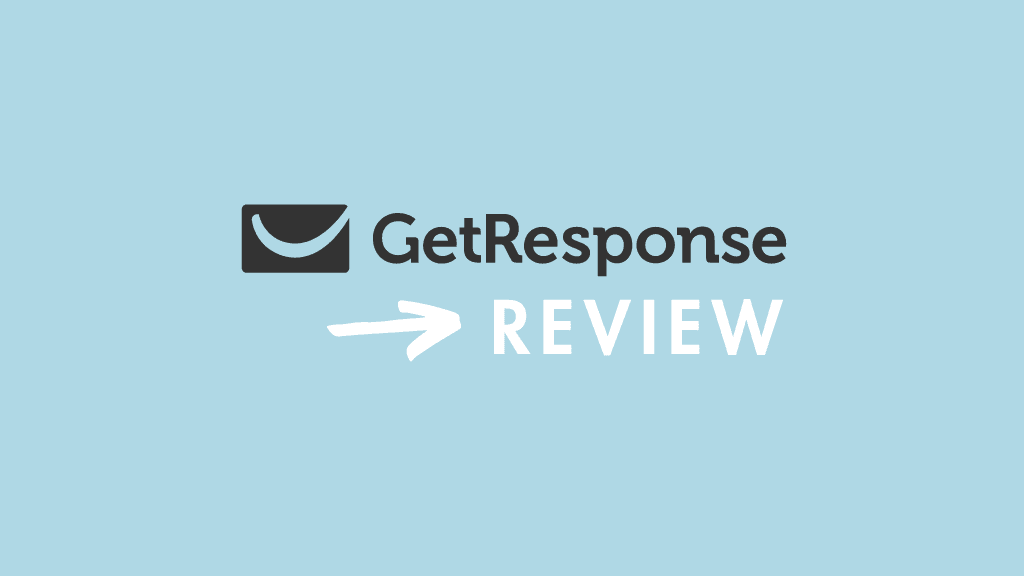
In this in-depth GetResponse review, I take a look at a well-known email marketing solution and drill down into all its key pros and cons. Is it right for your business — or should you use an alternative?
Let’s kick things off with look at the background behind GetResponse.
GetResponse: some background
GetResponse is an email marketing app that allows you to:
- create a mailing list and capture data onto it
- send e-newsletters to the subscribers on your list
- automate your email marketing using ‘autoresponders’
- view and analyse statistics related to your email campaigns — open rate, click through, forwards etc.
Founded in Poland in 1998, the company’s initial focus was on making it easy to send e-newsletters.
In recent years however, GetResponse has shifted its emphasis considerably — the product now aims to be more of an ‘all-in-one’ ecommerce and online marketing solution, rather than a ‘traditional’ email marketing tool.
Accordingly, in addition to email marketing features, GetResponse now provides a website builder, chat features, ecommerce features, webinar hosting, landing pages and automated sales funnels.
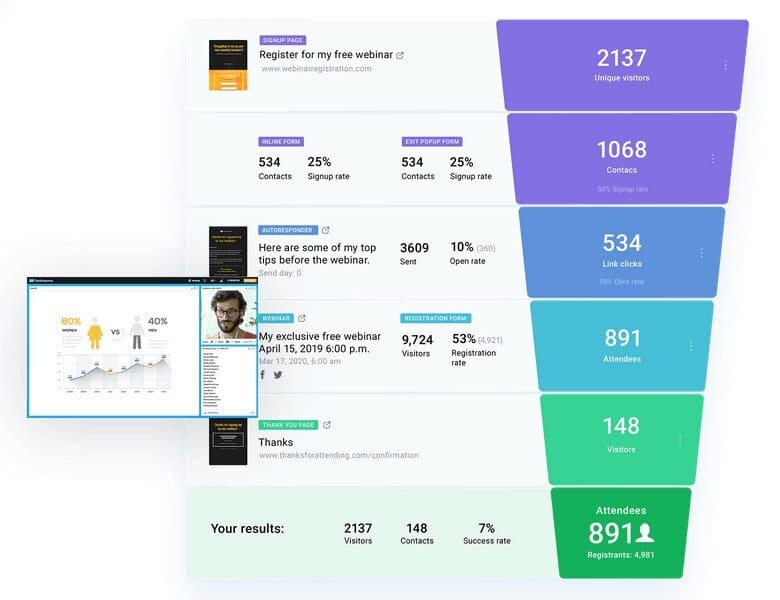
But how much does all this cost?
GetResponse pricing
There are five GetResponse pricing plans available.
- Starter — this starts at $19 per month and lets you send an unlimited number of emails to up to 1,000 subscribers.
- Marketer — this starts at $59 per month and lets you send an unlimited number of emails to up to 1,000 subscribers.
- Creator — starts at $69 per month and lets you send an unlimited number of emails to up to 1,000 subscribers.
- Enterprise – custom pricing.
As you add more subscribers to your list, your costs increase. At the top end of the scale, you can expect to pay $539, $599 or $690 per month to use GetResponse with a list containing 100,000 subscribers on the ‘Starter,’ ‘Marketer’ and ‘Creator’ plans respectively.
In order of expense, these are:
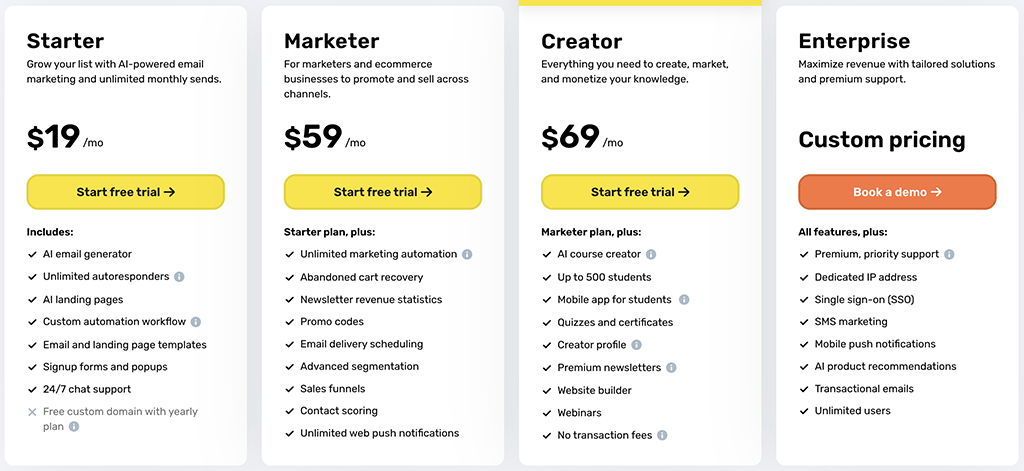
With regard to the ‘Enterprise’ plan, as its name suggests this is GetResponse’s ‘enterprise level’ offerings that provide advanced features (more on this shortly).
The exact pricing for GetResponse ‘Enterprise’ varies based on your requirements and list size. To get a quote, you’ll need to contact GetResponse to schedule a demo, discuss your needs, and negotiate pricing.
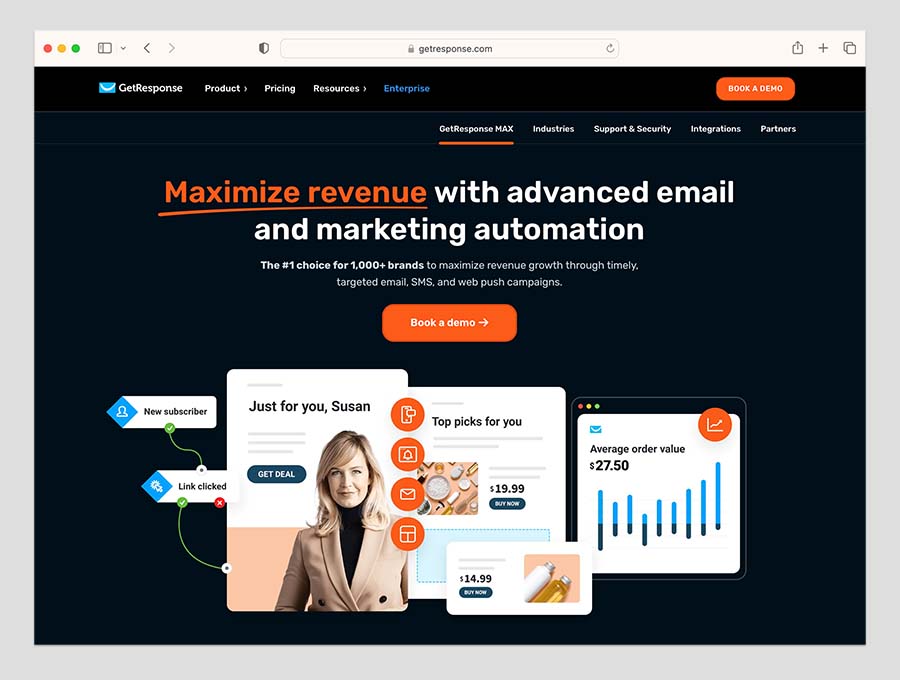
A discount is available if you pay upfront for one year — you get 18% off your plan when you do. That’s a slightly bigger annual discount than rivals Aweber and Mailchimp provide on their annual plans (16% and 15% respectively).
You can try the paid-for plans out for 30 days for free, via a trial that you can access here.
Key differences between plans
The core features common to all paid-for GetResponse plans are as follows:
- the ability to import and host a subscriber list
- a range of e-newsletter templates
- autoresponder functionality
- a landing page builder
- leads funnels
- Facebook and Google Ad management tools.
Now, there are a number of differences between the ‘Starter’, ‘Marketer’ and ‘Creator’ plans, but for me the key ones are as follows:
- The automation builder — arguably GetResponse’s standout feature, the automation builder (which allows you to build complex autoresponder sequences based on user behaviour) is only fully available on the ‘Marketer’ plan or higher.
- Conversion funnels — you get access to more automated sales funnels as you go up the pricing ladder.
- Webinars — this functionality is is only available on the ‘Creator’ plan and higher.
- Team management — you can only have three user accounts on the ‘Starter’ plan, but you get five users on both the on ‘Marketer’ and ‘Creator’ plans. On GetResponse’s ‘Max’ plan, you can have up to 500 users.
- Content monetization — only available on the ‘Creator’ plan, this feature lets you create and sell an unlimited number of courses, with support for up to 500 students on the $69 per month plan.
- Transactional emails — the abandoned order recovery feature (which automatically sends reminder emails to your site visitors who don’t complete an order) is only available on the ‘Marketer’ plan or higher. The same goes for order confirmation emails.
- Website builder — this functionality is is only available on the ‘Creator’ plan and higher.
- SMS marketing — the option to send marketing text messages is only available on the ‘Max’ plan.
- Support — phone support is only available on the Max plan, which also gives you access to a dedicated account manager (a ‘Customer Experience Manager’, to use the GetResponse term).
I’ll discuss these features in more depth as I progress through the review.
How does GetResponse pricing compare to that of its competitors?
So long as you are happy to use the entry level ‘Starter’ plan, you’ll find that GetResponse is on the whole, cheaper than many of its key competitors — particularly if you have a large number of email addresses on your database.
GetResponse’s starting price is competitive — you can host a database containing up to 1,000 email addresses for $19 per month with GetResponse, compared to $25.00 per month on AWeber or $44 per month with Campaign Monitor. The pricing for Mailchimp’s broadly comparable ‘Standard’ plan is $45 per month when used with 1,000 contacts.
As you go up the pricing ladder, GetResponse generally continues to come in cheaper than all these products.
A couple of other things to be aware of on the competitor pricing front are:
- Some solutions (Mailchimp being a prime example) charge you to host both subscribed and unsubscribed contacts, which can become a significant hidden cost. GetResponse only charges you for your active subscribers.
- If you are prepared to pay upfront for one year, you can avail of an 18% discount on any GetResponse plan. This is more generous than the discounts offered by several key competing products.
So the bottom line is that GetResponse stacks up well against competitors in the pricing department.
But what about features?
Key GetResponse features
By comparison with other email marketing tools, GetResponse comes with an unusually large feature set — even on its entry-level plan.
The platform provides all the key stuff you’d expect from an email marketing platform — list hosting, templates, autoresponders, analytics and so on, but as mentioned above, it’s been expanding its feature set to the point where it has morphed into an all-in-one marketing and e-commerce solution.
The question is whether all this makes the product a jack of all trades and master of none.
Let’s drill down into its features and find out, starting with visuals.
Email templates
There are 246 GetResponse templates available — less than some competing email marketing solutions (notably AWeber, which offers over 600) — but they are varied in nature and the designs are contemporary and easily editable.
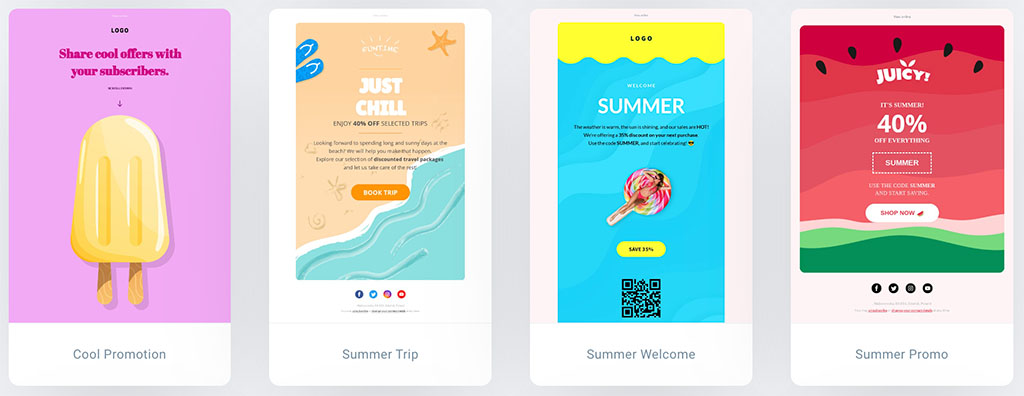
The email templates are grouped into a few categories focussed around core goals — promoting, educating, selling etc. — and their quality is generally high.
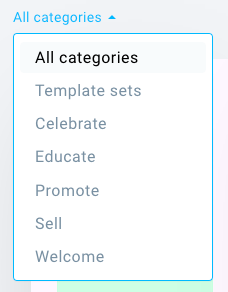
There is one omission worth flagging up however — the option to set ‘global’ styles for headings and text.
As things stand, the template editor doesn’t let you define heading and paragraph styles that you can re-use throughout a message — this means more manual formatting of text as you compose emails, which is a bit of a pain.

On the plus side, the GetResponse email creator allows you to make very extensive use of web fonts. A huge selection of Google Fonts can be used in your e-newsletters — more than any competing tool that I’ve tested to date.
This wide selection of web fonts is great, because — given the prevalence of Google fonts in corporate branding these days — it will let many users create email campaigns that align closely to their brand.
It’s important to remember that not all email apps support use of web fonts — you can specify a ‘fallback font’ in GetResponse to accommodate these — but in the email programs that do, e-newsletters created via GetResponse tend to look very nice indeed.
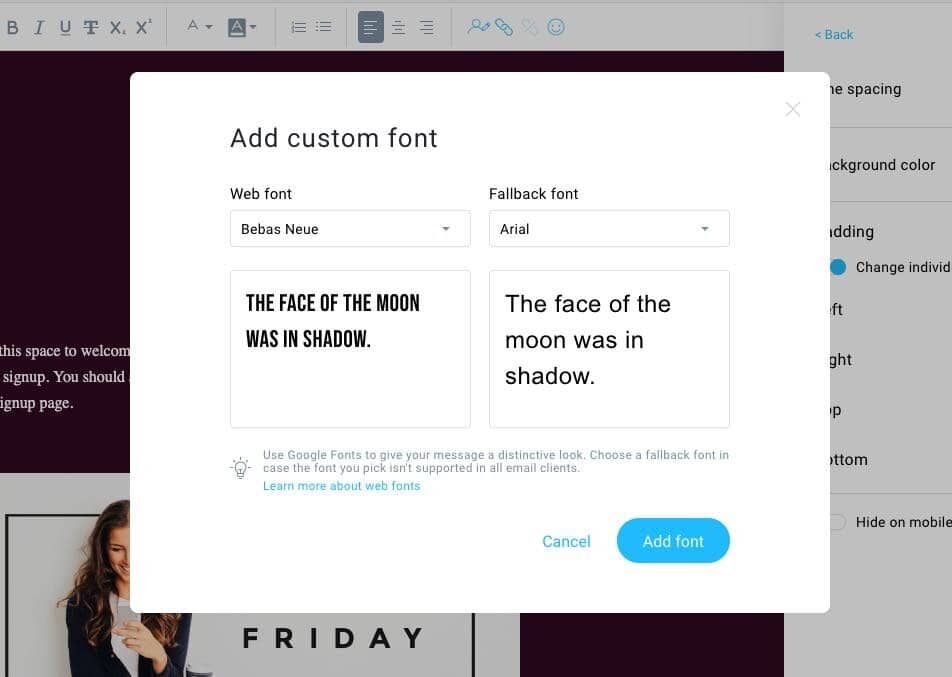
Finally, the GetResponse templates are all responsive, meaning that they adjust themselves automatically to suit the device that an e-newsletter is being viewed on — mobile, tablet, desktop computer etc.
A preview function is available to see how your newsletter will appear on desktop and mobile.
(It would be nice if a tablet preview option was available too — although in truth, most tablet devices display emails in a fairly similar way to desktops).
AI tools in GetResponse
GetResponse recently added some new artificial intelligence tools to help you quickly create e-newsletters.
The first of these is its AI subject line generator.
This tool creates email subject lines based on your chosen keywords, providing you with 5 subject line suggestions to pick from. When you pick one, you can choose to leave it as is, or alternatively, edit it in the GetResponse email editor.
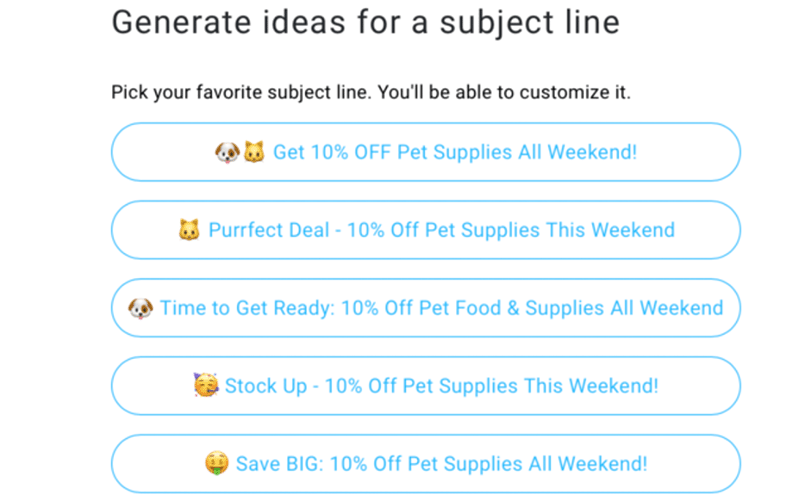
GetResponse’s second artificial intelligence tool is an AI Email Generator.
Powered by Open AI’s ChatGPT-4 technology, this tool generates the full copy, layout and design for your email based on your prompts.
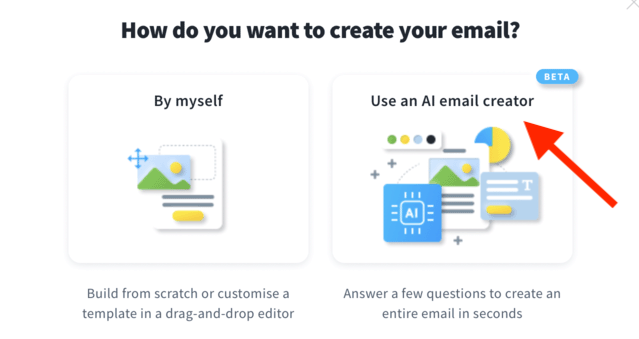
It lets you choose from a range of six ‘tones of voice’ for your email copy: ‘convincing,’ ‘formal,’ ‘inspirational,’ ‘informative,’ ‘friendly,’ and ‘neutral.’
Finally, GetRepsonse’s new AI Autoresponder Generator lets you quickly create industry-specific autoresponder messages for your subscribers, again by using ChatGPT-4.
Although these AI tools are in their infancy, they work well, and may radically change GetResponse’s email newsletter creation process as more functionality is added to them.
Autoresponders
Autoresponders are e-newsletters that are sent to your subscribers at intervals of your choosing.
For example, you can set autoresponders up so that…
immediately after somebody signs up to your contact list, they receive a welcome message from your business
a week later they receive a discount offer for some of your products or services
three weeks later they receive an encouragement to follow you on social media.
And so on.
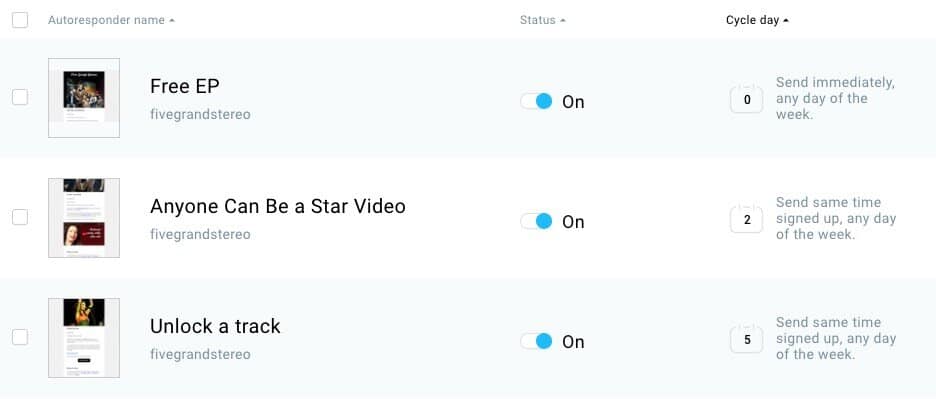
GetResponse’s autoresponder functionality is a key selling point — so long as you are on one of its paid plans, the product provides some of the most comprehensive autoresponder functionality available.
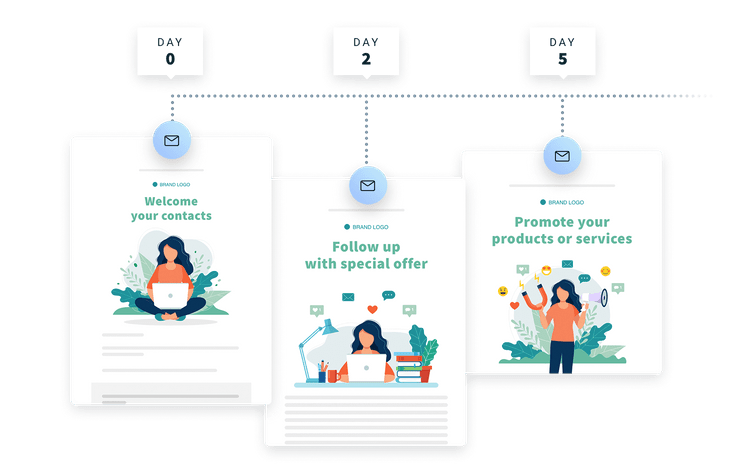
You can use GetResponse autoresponders to send either time-based or action-based messages. Time-based options include cycles like the one highlighted in the example above, and action-based messages can be triggered by user actions or information, for example…
- opens
- clicks
- subscriptions to particular lists
- changes in contact preferences
- completed transactions / goals
- birthdays
- changes in user data.
Marketing automation tools
In addition to the basic ‘drip’ style autoresponders mentioned above, GetResponse provides a more sophisticated option for sequencing emails automatically.
This is called ‘Marketing Automation,’ and is only fully available on ‘Marketer’ plans or higher.
The feature allows you to create automation workflows using a drag and drop editor — you basically set up an ‘automation flowchart’ that instructs GetResponse what to do if a user opens a particular offer, clicks on a certain link etc.
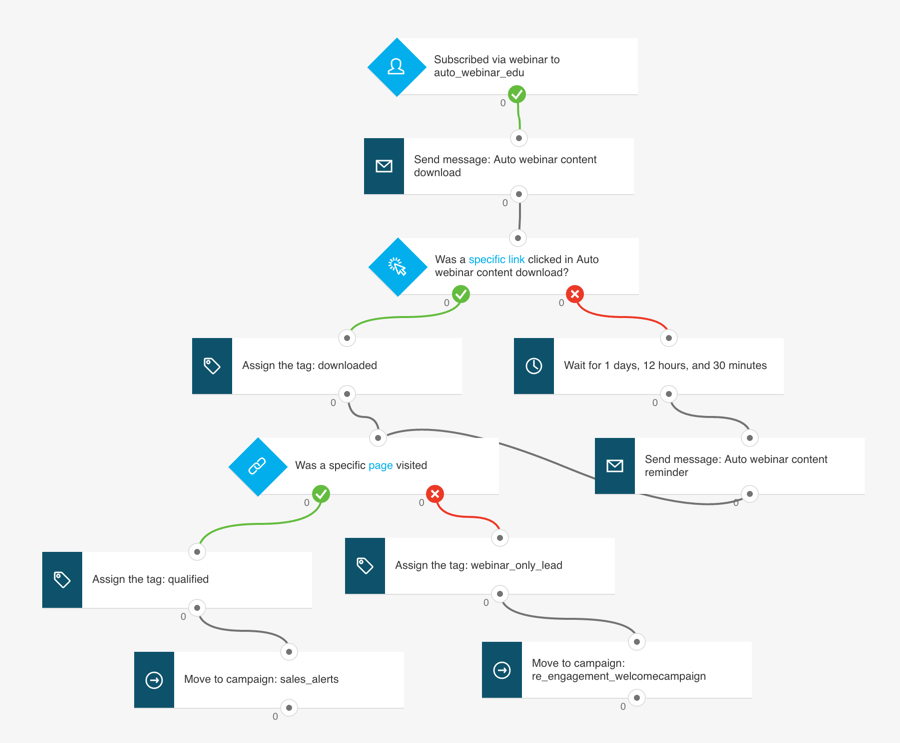
The functionality on offer here goes far beyond what’s traditionally been available from autoresponders, and allows you to create a user journey that can be customized to an enormous degree.
You can learn more about GetResponse’s marketing automation features here.
Split testing
Split testing involves sending variants of your e-newsletters to some of the people on your subscriber list, monitoring the performance of each, and sending the ‘best’ version to the remainder of your list.
GetResponse allows you to run split tests using up to five subject headers OR content variants.
However, you can only use one variable at a time during a split test — for example, you can test emails with different subject lines against each other, but both versions of the email must contain the same content (or vice versa).
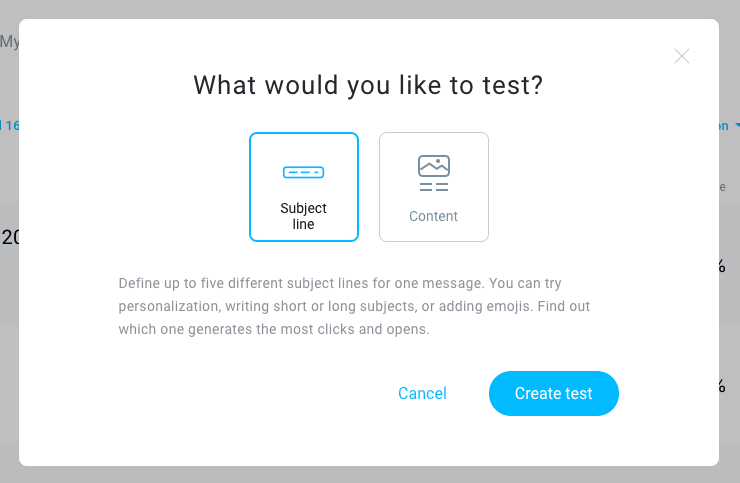
I’ve found many other email marketing tools to be more flexible in this regard, allowing you to test using more variables (for example send time or sender name), or the option to mix variables during tests.
So, GetResponse could do better here.
Perfect timing?
Although GetResponse’s split testing functionality could be better, it has some sending features which makes up for its shortcomings quite a bit — its ‘Perfect timing’ and ‘Time travel‘ tools.
The ‘Perfect timing’ tool automatically sends your email at the time at which it’s most likely to be opened (GetResponse examines your subscriber’s past email-opening habits to work this out).
And the ‘Time travel’ tool sends your message to subscribers in different time zones at a specific local time. So, for example, you can ensure your message gets delivered at 9am (local time) to all subscribers no matter where in the world they are located.
Landing page creator
When it comes to lead generation, GetResponse offers something very useful that many of its competitors don’t: a landing page creator.
There are currently 93 landing page templates to choose from — and as with GetResponse’s email templates, these are professional and contemporary in appearance (particularly the more recently-introduced ones).
Landing pages are usually a core part of any online advertising campaign — online ads usually generate far more leads if, rather than simply directing people to an information-heavy web page, they point users to attractive ‘squeeze pages’ containing limited but clear information and a clean, well-designed data capture form.
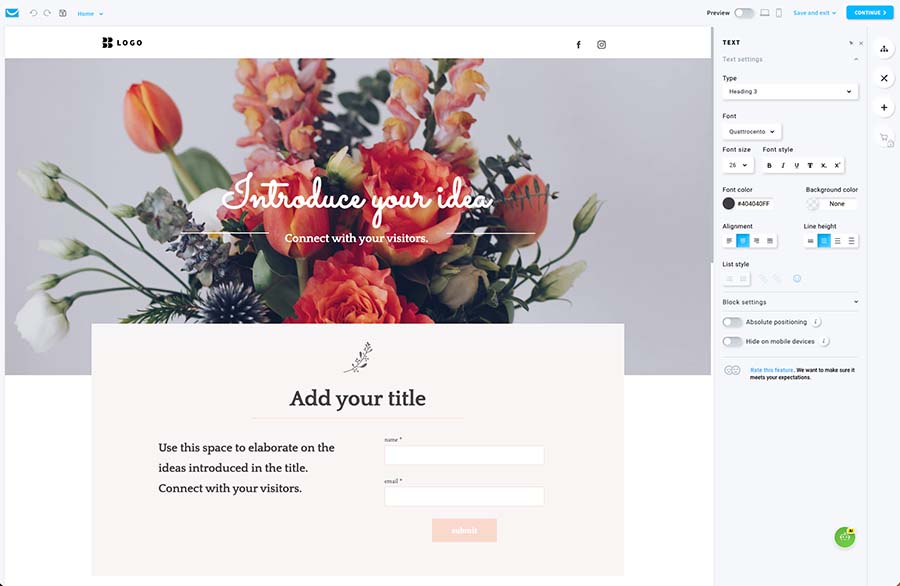
GetResponse lets you build sophisticated squeeze pages out of the box. Significantly, you can test the conversion rate of these pages against each other in real time — and choose the best performing one for your ad campaigns.
This can have a very positive effect on the number of leads you capture, and improve the reach of your email campaign.
Competing email marketing tools often require you to make use of a third-party landing page creator to attain this sort of functionality, so the inclusion of the landing page feature is a really useful — and cost-saving — piece of functionality to have in your email marketing toolbox.
Crucially, GetResponse’s landing page functionality is available on all plans — even the free one.
Given that leading landing page tools Unbounce and Instapage charge a minimum of $74 and $79 per month respectively, there are considerable savings to be made on squeeze pages by using GetResponse.
The landing pages you create can be hooked up to a wide range of analytics tools and cookies, such as Google Analytics, Google Tag Manager, Yandex Metrica and your Facebook pixel.
And significantly, the landing page builder is, broadly-speaking, GDPR compliant. In order to meet the EU’s GDPR requirements on cookies (and some US states’ data protection laws too), you have to give users a clear mechanism to opt in or out of cookie use before those cookies are run.
And unlike many competing products, GetResponse lets you do this, giving you the option to provide users with a cookie notification that lets them accept or decline the analytics cookies mentioned above.
I discovered a couple of areas where GetResponse’s landing page creator could be improved, however.
First, the landing page interface is not particularly intuitive — in fact, it’s pretty clunky.
Second, you don’t get much control over the mobile version of your landing page — you can’t do much more than tweak the font sizes and margins.
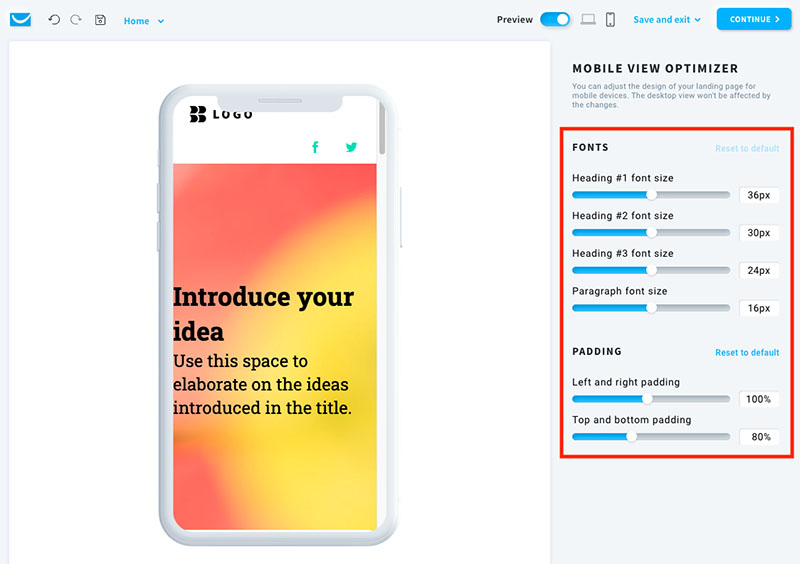
And finally, the landing pages could load a bit quicker — when I tested them in Google’s Page Speed Insights tool, it indicated that there’s room for improvement to their page loading times (the faster that pages load, the better they typically convert).
Overall though, the landing page creator is a good feature — and one that adds a lot of value to GetResponse.
Webinars
GetResponse recently introduced the ability to host webinars on the platform, available on the ‘Creator’ plan or higher.
Given that webinars can be used both as a lead-generation tactic and an important revenue-generating feature, the idea of having your email database and your webinar tool under the same roof is very appealing.
The pricing is also very competitive too by comparison to established webinar solutions, especially when you factor in all the additional marketing features that GetResponse provides.
For example, one of the market-leading webinar hosting services, GoToWebinar, charges $59 per month just to host live webinars. You can do the same — and a whole lot more — with GetResponse for just 10 dollars more on the $69 ‘Creator’ plan.
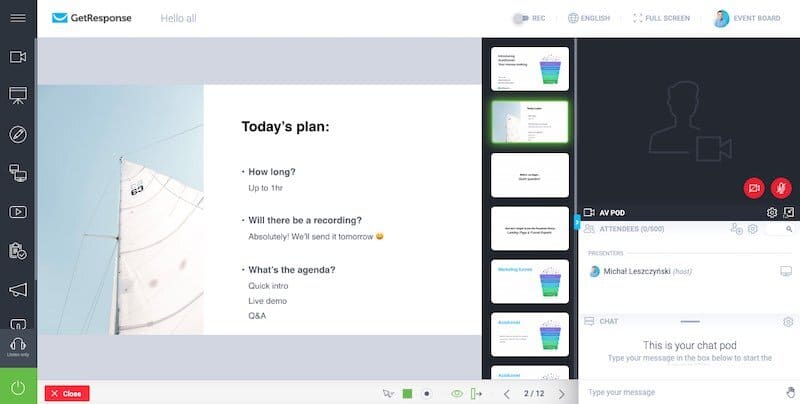
If I’m honest, because I’ve found some aspects of the GetResponse interface — especially landing pages — a little bit clunky in the past, I wasn’t expecting that much from the webinars feature.
But I was pleasantly surprised: both the webinars interface and functionality are really excellent — and are generally up there in terms of quality with any dedicated platform I’ve used in the past for online meetings or webinars.
A few GetResponse webinar features that I found particularly useful are:
- the lack of a need for your attendees to install any software to participate in the webinars
- one-click record of your webinars
- screensharing functionality
- the ability to host a webinar with up to three presenters
- video sharing functionality (YouTube)
- the option to upload Powerpoint presentations to GetResponse for use during a webinar
- the option to use pre-recorded webinars or past events as part of a sales funnel (as part of GetResponse’s ‘on-demand webinars’ feature)
- the ability to run ‘breakout rooms’ for attendees (available on GetResponse ‘Max’ plans).
The main drawback I encountered while testing this feature was the file storage limits for your recorded webinars. They aren’t particularly generous — you get just six hours storage on the ‘Creator’ plan and 20 on the ‘Max’ plan.
So, if your business is very much focused around webinar content, you may need to use a separate storage solution to share them with attendees, and this isn’t ideal.
But overall, the webinar functionality provided is a very useful feature to have in your email marketing arsenal, and its inclusion as a feature gives GetResponse a significant edge over its key competitors. The fact that your email list is fully integrated with your webinar broadcasting tool is a serious plus point, and the quality of this feature is surprisingly high.
Let’s look at another feature now that is also pretty unique to GetResponse: “conversion funnels.”
Conversion funnels
Another feature that distinguishes GetResponse from competing products is its ‘conversion funnels.’
This is because — to a degree — it turns GetResponse from being an email marketing platform into something that you can use to run an entire ecommerce business.
The idea behind this feature is that you can do the following things without ever leaving the GetResponse environment:
- Create a product catalog
- Create and run Facebook ad campaigns
- Create landing pages
- Add subscribers to an autoresponder cycle
- Drive users to sales pages (also created in GetResponse)
- Take payment for products
- Send abandoned cart emails if necessary
You can access the conversion funnel feature on GetResponse’s ‘Marketer’ plan and higher — but you should note that webinar funnels are only available on the ‘Creator’ plan.
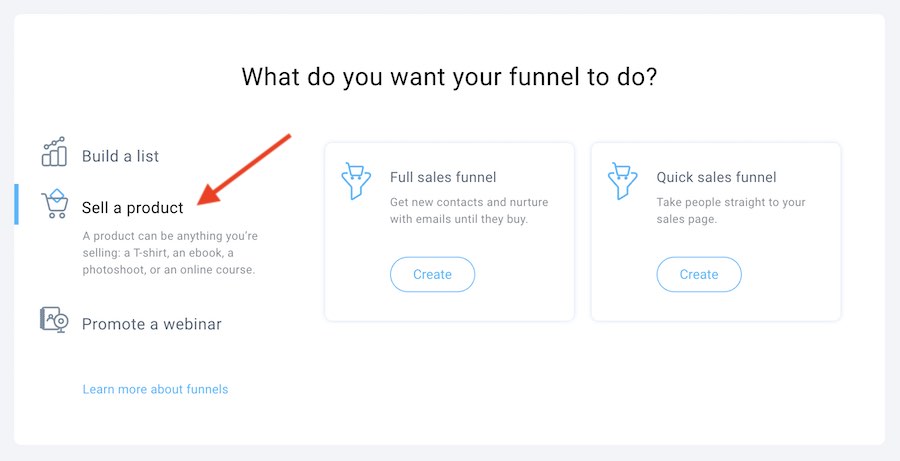
If you like, you can involve third party platforms with GetResponse conversion funnels — for example Shopify, BigCommerce and Etsy can all be integrated with GetResponse (in some cases via official integrations, in others via syncing tools like Zapier).
As things stand, this feature is probably best suited towards ‘solopreneurs’ or small businesses who want an all-in-one option for creating all the assets they need to produce a sales funnel.
Merchants with large product catalogues and extensive ecommerce requirements will still probably be better off using a dedicated ecommerce solution like BigCommerce or Shopify for the actual selling part of the mix, however.
Website builder
GetResponse’s website builder feature lets you create a site within the GetResponse interface and connect it to a domain you own (you can also, if you like, buy your domain through GetResponse).
The templates for the website builder are pretty good and there are a lot of them (around 130). But as things stand, the tool is a fairly basic affair, only letting you create simple, static pages.
Additionally, you can only use the website building tool if you are on GetResponse’s ‘Creator’ plan or higher.
The ‘Creator’ plan lets you build up to five websites, while the ‘Max’ plan offers the flexibility to create more based on your custom setup.
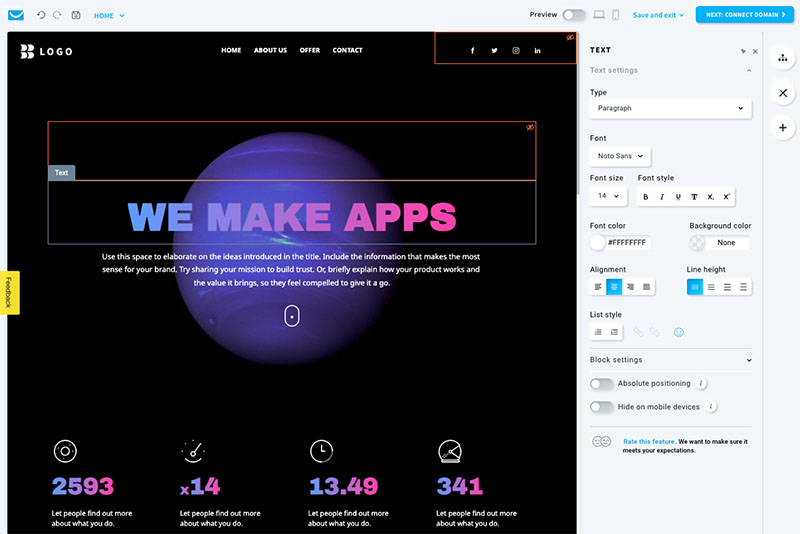
You can add GetResponse forms very easily to these websites, which is helpful, but I couldn’t find an obvious way to add any products I had created in GetResponse to a test website that I put together with the builder.
So if you’re hoping to start an online store with this tool, you will be a bit disappointed.
As a means for creating a simple brochure website though, it will work pretty well for some (especially web design novices, who might find its automated ‘AI’ builder — which builds a website for you based on answers to some questions about your project — a fairly non-threatening way to get a website off the ground).

One thing to note about GetResponse’s website builder is that the sites it creates aren’t terribly fast, and there is general room for improvement where Google’s Core Web Vitals‘ website speed and stability standards are concerned.
Based on my tests, the mobile versions of sites built with GetResponse didn’t score highly when it came to site speed or Core Web Vitals. That said, the desktop versions did perform reasonably well for me on both counts.
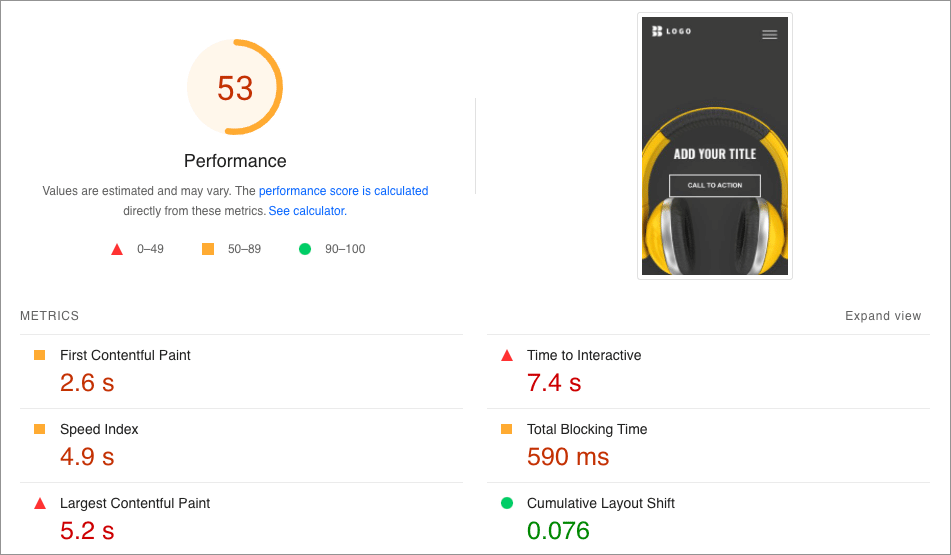
And to be fair to GetResponse, this tends to be an issue for a lot of other ‘hosted’ website building tools — well-known platforms like Wix and Squarespace can present problems in this area too.
So overall, I found GetResponse’s website builder feature a bit underwhelming. But the idea of having everything in one place — website, email marketing, webinars — is definitely an attractive one, particularly if you run a small business.
As things stand however the feature needs a bit of work if it’s going to compete against more established website and online store builders like Big Cartel or Shopify.
Don’t miss out on our free Business Growth E-Kit
For a limited time only, we’re offering our readers some excellent free tools to help them grow their business. Sign up free to immediately receive:
- downloadable cheatsheets on how to grow an online business
- an exclusive discount code for email marketing app GetResponse
- a 30-day free trial of Canva Pro
- extended free trials of essential growth-hacking apps
- ongoing free tips and advice on digital marketing
We respect your privacy, and you can unsubscribe any time. View privacy notice.
Live chat
In the spirit of trying to be an ‘all-in-one’ marketing solution, GetResponse has added a ‘chat’ feature that adds live chat functionality to your website (either one you’ve created via GetResponse’s new website builder feature, or your own existing site).
This feature is only available on GetResponse’s ‘Marketer’ plan or higher, and one of its biggest advantages is that you can use it to embed chats on external websites, not just those built with the GetResponse website builder.
To enable GetResponse Chats, you add a snippet of code to your site which then displays a live chat option to your visitors.
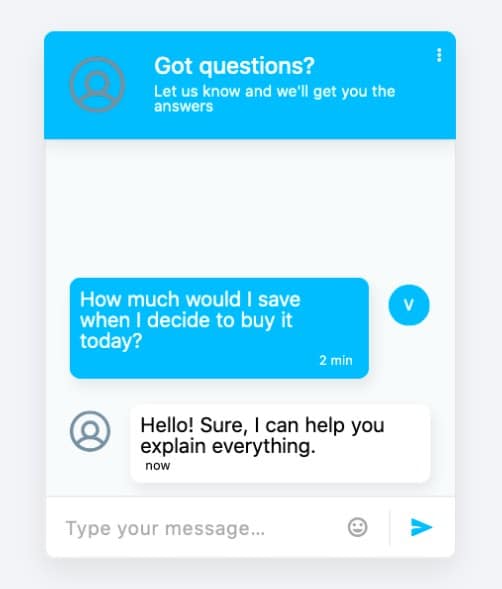
This is a pretty nifty little feature, which used correctly can help you increase conversion and subscription rates. And thanks to recent updates
However, as with all features like this there is a trade-off — adding more interactive tools like this to your site via scripts can have a negative impact on page loading times (which in turn can affect your site’s performance in search results).
But there are lots of contexts where this sort of functionality will come in very useful, so it’s definitely a nice addition to GetResponse’s feature set, and one that will bring real value to users.
Web push notifications
Another GetResponse feature that is not strictly related to email marketing is the facility it gives you to create web push notifications.
By adding a snippet of GetResponse code to your site, you can let visitors to your site opt in to browser-based notifications (which you can display to your site visitors in future regardless of the website they’re browsing).
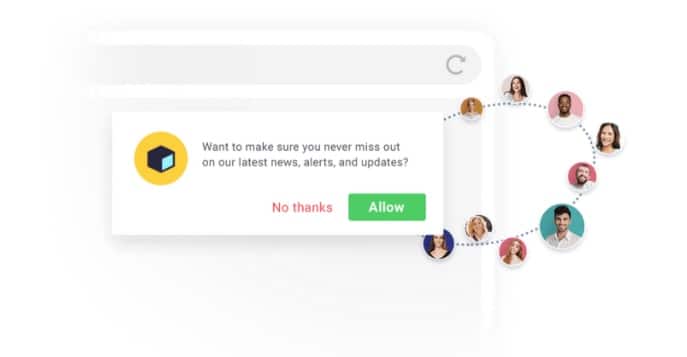
You can use these notifications as part of an automated subscriber journey too — for example, 30 minutes after a subscriber clicks on a link in an email about a promotion you’re running, you could display a push notification in their web browser about that particular offer.
This is pretty sophisticated stuff — but some people find push notifications annoying, so it’s a feature that should be used judiciously.
The web push notifications feature is available on the ‘Marketer’ plan or higher.
Apps and integrations
If you want to integrate GetResponse with another platform or tool, there are around 258 integrations to help you do so.
You can use these to hook GetResponse up to popular ecommerce solutions and content management systems, including WooCommerce, Shopify and WordPress, as well as some CRM systems, like Capsule and Zoho.
I found quite a few useful Google integrations available for GetResponse too. These allow you to import contacts; add Google Analytics tags to an email campaign; and link your landing pages to Google Ads in a way that helps you better measure the effectiveness of your PPC campaigns.
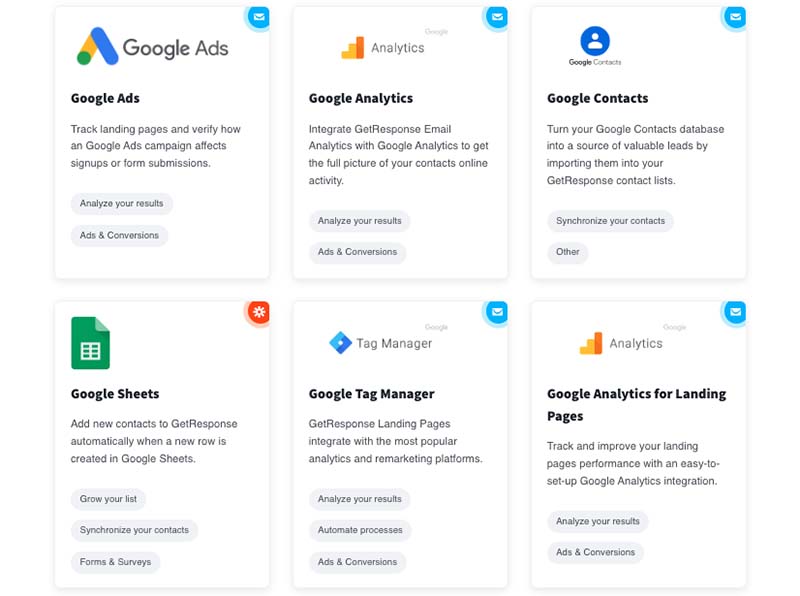
GetResponse also works with the syncing tool Zapier, which can help you connect it to other tools via ‘zaps’ based on ‘if this, then do that’ rules.
And, assuming you have the development skills to do so, you can also integrate GetResponse with other software by using the platform’s API (Application Programming Interface). This lets you send and receive data to and from GetResponse in whatever way suits your application.
Analytics
GetResponse offers a good range of analytics and reporting options.
You get all the basics of course — open rate, click-through, unsubscribe rates and so on — but in addition to that, there are some very nifty reporting features that are worth a particular mention, namely:
- ‘one-click retargeting‘: a way to easily identify people who engaged or didn’t engage with a particular newsletter, and send them an appropriate follow-up
- ‘email ROI‘: by adding some tracking code to your post-sales page on your site, you can find out how effectively (or not!) your email campaigns are driving sales, and work out your return on investment in email marketing.
- per-user information — you can click on one of your subscribers and see where they signed up from, where they’re located and which emails they’ve opened in the past.
- e-newsletter performance comparison — you can compare the performance of two e-newsletters side-by-side really easily.
Mailchimp and AWeber offer some similar reporting functionality — particularly where sales tracking is concerned— but GetResponse’s reporting tool is definitely one of the more fully-featured available.
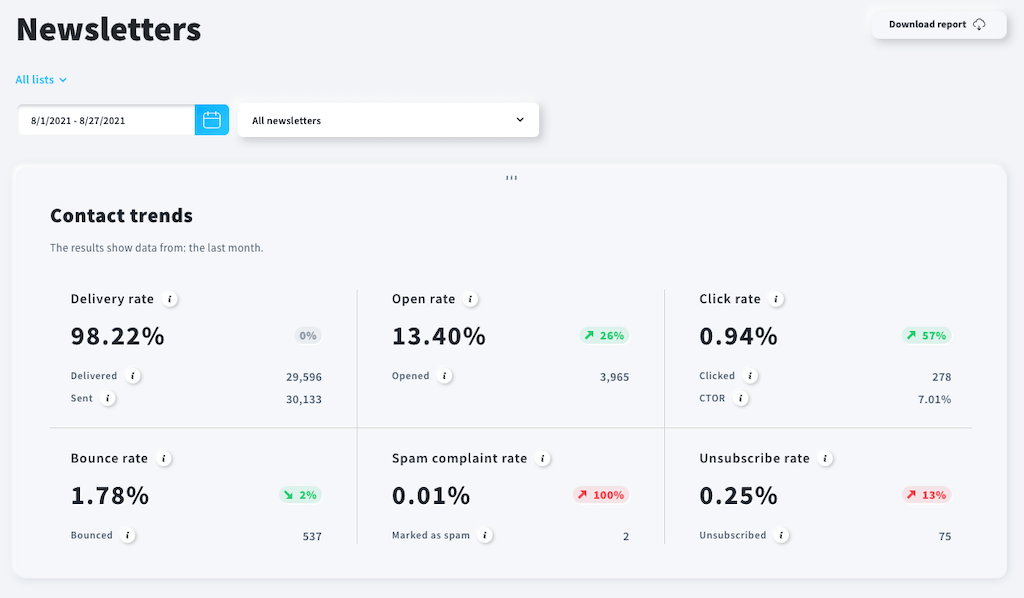
Data management and deliverability
Data capture and forms
There are two ways to use forms in GetResponse — you can either add a HTML form that you style yourself, or you can design your form in GetResponse itself, choosing from a decent range of templates and configuring them so that they match your site’s design.
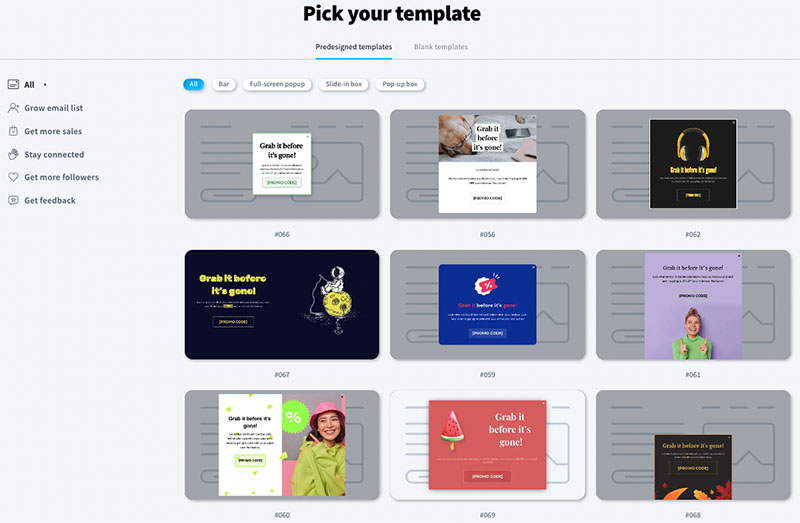
If you go down the latter route, you can add the form to your site using a snippet of Javascript code to display your form; this form can be presented in a range of different formats (for example bar, full-screen, pop-up box or slide-up).
You can use both the HTML forms and the javascript ones to capture data into standard GetResponse fields, or, if you prefer, populate custom fields.
And you get the option to send users an opt-in confirmation message or add users to an autoresponder cycle too.
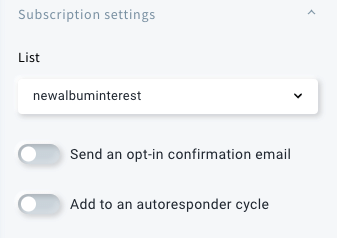
Possibly the best aspect of the form creation tools is the level of control you get over how your popup forms are triggered — and the audience you’d like to display them to.
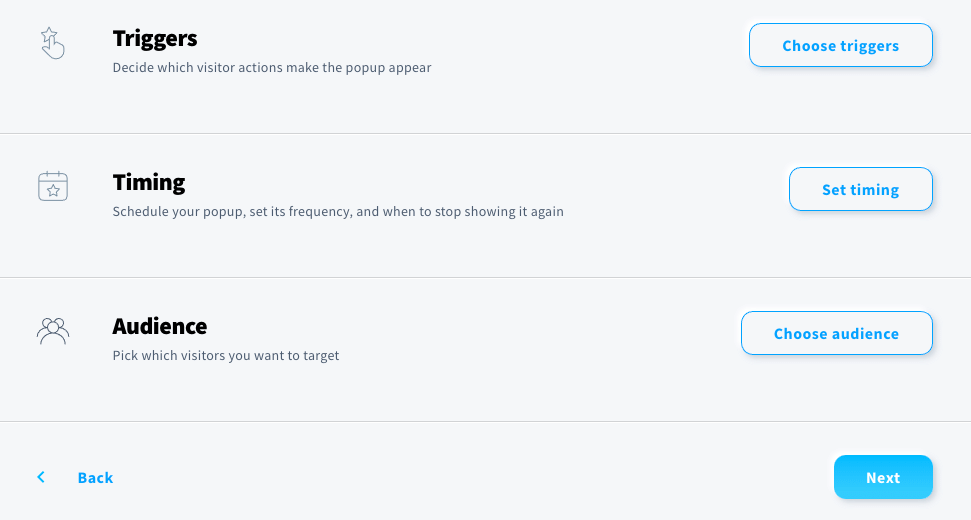
You get the option to specify what triggers your popups (timing, scroll events, page exits or inactivity); how many seconds to wait before showing them; and the devices you’d like to display them on.
(Not only can GetResponse popups capture email addresses, they can also be used to display promo codes or encourage site visitors to follow your business on social media).
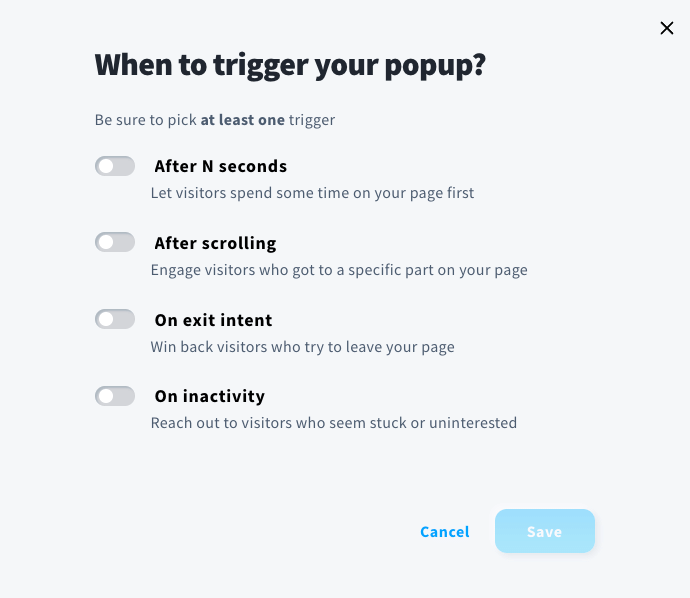
These controls give you a lot of flexibility over form implementation and represent a big improvement over GetResponse’s old form designer (especially where form audiences are concerned – the old designer didn’t give you any device-level controls at all).
Tip: remember to use pop-ups judiciously. There are certain situations where they can be a fantastic driver of sign-ups, but they can also impact negatively on your SEO – Google is not a fan of overly intrusive popups.
Data segmentation options
One of the things I like most about GetResponse is the way you can send emails to multiple segments of subscribers at once (or indeed exclude multiple segments). Oddly, this is something not always faciliated by competing solutions, even well-known tools like Aweber.
Say you have a subscriber list in GetResponse that you’ve divided up into four segments:
- Segment A
- Segment B
- Segment C
- Segment D
With GetResponse, it’s really easy to message segment A, B and C all at once (you just tick three relevant checkboxes). You could also message segment B and C and exclude segment D.
Not only can you message or exclude multiple segments at once, you can also do the same with individual lists — for example, if you had three separate mailing lists on GetResponse, you could mail individuals across all three of them.
For me, this sort of flexibility marks GetResponse out from its competitors because it really lets you tailor your email campaign audience to the nth degree — of the similar products I’ve reviewed to date, only Campaign Monitor offers a comparable level of flexibility (and one that comes at a much higher price).
The only downside to watch out here for is that some segmentation options (based on scoring, tags, ecommerce and events) are only available on GetResponse’s ‘Marketer’ plan or higher.
GetResponse deliverability
Email deliverability rate — the percentage of e-newsletters sent that successfully reach your subscribers’ inboxes — is obviously an important thing to look at when choosing an email marketing tool.
Not all email marketing providers are that transparent about their deliverability rates, but GetResponse seems reasonably open about this, with this to say about it on their website:
We are frequently asked about the quality of our deliverability rate. Because deliverability depends on many factors, including the content of your messages, the deliverability rate could vary for each mailing. For all our customers collectively, however, we are proud to say our overall deliverability rate currently stands at 99%.
GetResponse
(For the record, my own tests of the platform suggest that users can expect a deliverability rate of 98.5% or higher, which chimes with the above statement).
Furthermore, GetResponse actually gives you the deliverability rate of each message on your email analytics — this is something I haven’t encountered on a lot of competing products’ metrics.
Finally, Custom DKIM — an authentication technique designed to enhance security for the senders and receivers of email — is also available on all GetResponse plans (even the ‘Getresponse Free’ one). This can further improve deliverability.
GDPR
When GDPR (General Data Protection Regulation) laws were introduced, email marketing got rather more complicated. GDPR specifies stricter rules about what constitutes consent to receive e-newsletters (and requirements about how that consent is logged).
GetResponse is to be commended for providing users with clear information about what their GDPR responsibilities are, along with special GDPR fields that make it easier to log consent and comply with relevant regulations.
Additionally, you can enable two-factor authentication (2FA) for GetResponse login. This ensures that a user is granted access only after successfully presenting two or more pieces of information — for example, a password and a code generated by an authentication smartphone app.
Given that data security is a key aspect of GDPR, this is a good feature to have in place.
Ease of use / interface
On the whole, I found GetResponse pretty user-friendly to use.
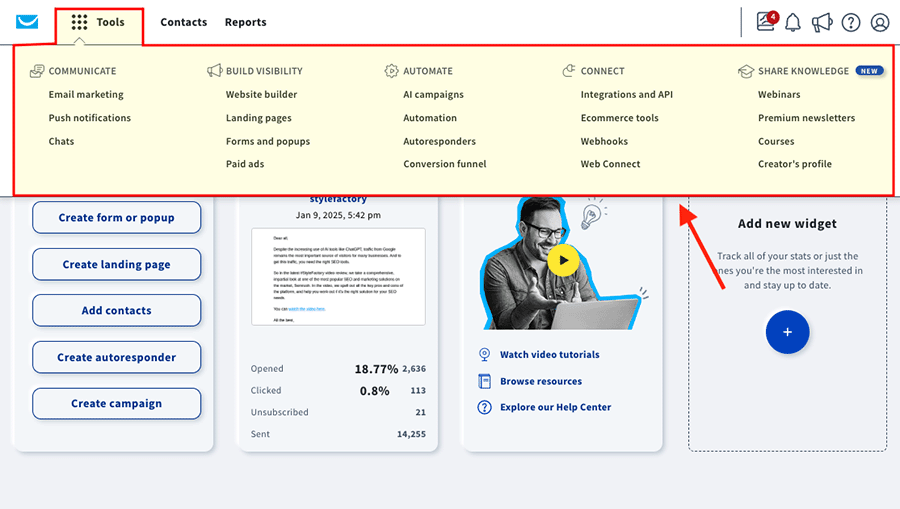
A drop-down menu at the top of the interface gives you access to all the core features; and, thanks to an editable ‘widget library’ (pictured below), you can customize the GetResponse dashboard so that your most regularly used tools and reports are easily accessible.
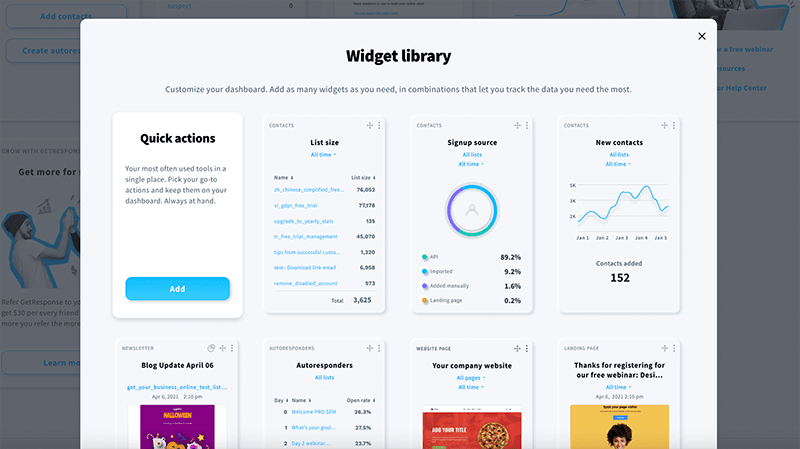
It is also easy to keep all of your uploaded images nicely organized thanks to a folder management system, which is accessible from the main GetResponse menu.
As for using the product, it’s certainly easy enough to do all the basics in GetResponse — import contacts, create an email campaign, set up autoresponders and check statistics. In particular, and as mentioned above, the segment management is excellent.
I’d probably like to see a few improvements made to the email editor, however (pictured below). Despite improvements over recent years, it can occasionally be a bit clunky to use — particularly where text formatting is concerned. When creating emails with it, it seemed to want to change my preferred font size at any given opportunity!
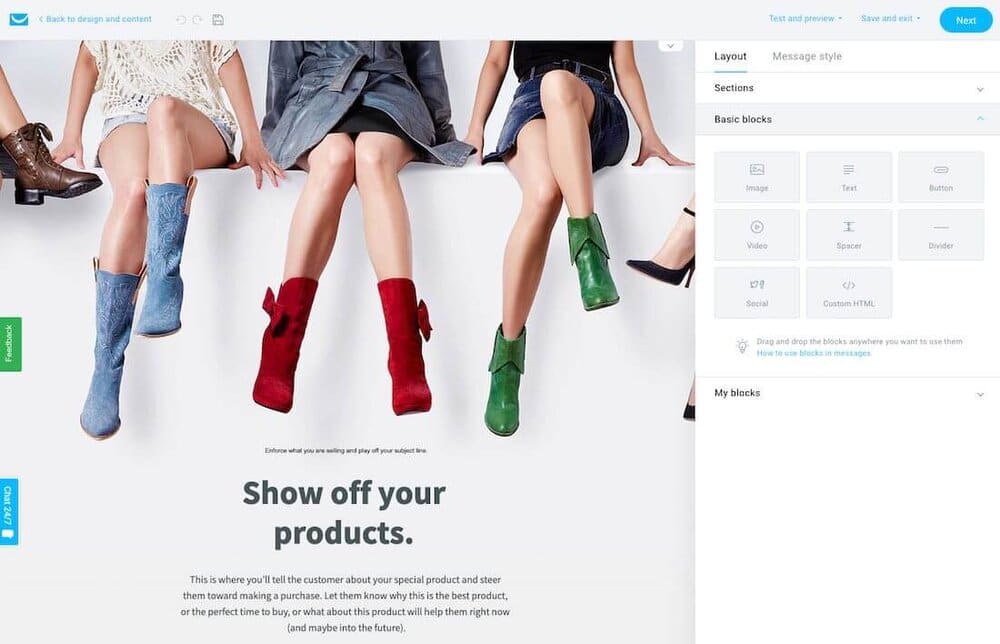
I also feel some improvements could be made to the subscriber journey designer interface — it looks and feels a bit dated, and while powerful, doesn’t provide the nicest of user experiences.
In terms of how the GetResponse interface stacks up against those of key competitors, I would argue that Campaign Monitor is a bit more user friendly, and that the Mailchimp interface features a cleaner design. AWeber’s interface probably comes closest in terms of look and feel.
User reviews and ratings
Throughout this review you’ve heard my take on the quality of GetResponse’s features. But what do real-world users think? To give you a sense of this I compiled some data from leading software comparison sites. My findings were as follows:
| Review site | User ratings (out of 5) |
| Capterra | 4.2 (514 reviews) |
| G2 | 4.3 (1,098 reviews) |
| TrustPilot | 3.9 (821 reviews) |
| TrustRadius | 4.4 (83 reviews) |
| Average user rating | 4.2 |
So overall, a decent average rating from users — 4.2 out of 5, which is very respectable and aligns fairly closely with the Style Factory rating (4.3).
Customer support
GetResponse customer support used to be amongst the most comprehensive available for email marketing tools — the company offered phone support alongside live chat support, email support and various online tutorials and resources.
Sadly, the phone support has now been discontinued, unless you’re on its enterprise plan. Other users will have to use live chat (24/7) or email support.
On the plus side, I have had extremely good experiences with GetResponse’s chat service — I’ve never had to wait long to chat with an agent, and anyone I’ve dealt with has had a remarkably robust technical knowledge of the platform.

And the email support provided by GetResponse is available in 7 languages, which is commendable. These are: English, Polish, German, French, Spanish, Italian and Portuguese. Live chat support is available in English and Polish.
I’ve sometimes found the response time via email support to be a bit longer than I’d like, however.
GetResponse review conclusion
Overall, GetResponse gives you a very cost-effective way to create email marketing campaigns. It’s priced very competitively in its marketplace, and is also one of the more interesting email marketing products that I’ve tested, in that it’s not just for sending e-newsletters — it also facilitates ecommerce, sales funnels, live chat, push notifications, webinars and web design.
It’s hard to think of any competing email marketing solution that represents quite as much of an ‘all round’ proposition, and this makes it a particularly good fit for business owners who don’t have the biggest budget, but need multiple marketing tools.
I’ve been particularly impressed by GetResponse’s webinar functionality — it’s feature packed, and very good value for what it is.
Some improvements to GetResponse do need to be made however. In particular, the website builder could do with some additional features, especially where ecommerce is concerned.
The landing page creator, while a really useful feature to have, would benefit from an easier-to-use interface.
And finally, GetResponse’s webinar storage limits are not generous.
I’ll sum up this GetResponse review with a rundown of the key pros and cons of using the product, which you’ll find below. Remember however that the best way to get a sense of the product is to try it out yourself, and you’ll find a free trial of it here.
And if you’ve got any views on GetResponse, do just leave a comment below — we’d love to get your thoughts, and will do our best to answer any questions you have.
Pros and cons of GetResponse: summary
Pros of using GetResponse
- So long as you are happy to use its ‘Starter’ plan, GetResponse is cheaper than many of its key competitors (in certain cases, significantly so) whilst offering just as much, if not more, functionality as them.
- It gives you extremely sophisticated tools for marketing automation.
- Its flexible approach to data segmentation makes list management really straightforward — it outshines many competing products on this front.
- GetResponse’s webinar functionality is great, and represents a genuine USP — I haven’t come across this functionality on similar products.
- The ‘Chats’ feature will prove to be a really useful addition to a lot of websites and used well can improve conversion rate significantly.
- Its content monetization tool is a standout feature, allowing you to create and sell unlimited courses on the ‘Creator’ plan. This makes GetResponse not just an email marketing platform but also a viable solution for online course creators.
- All GetResponse plans come with a useful, GDPR compliant landing page creator that facilitates A/B testing — something that could potentially save you a lot of money.
- The new form designer gives you a lot of flexibility over popup forms and the data they capture.
- Custom DKIM is provided on all plans, even the free one.
- Support is provided in a wide variety of languages.
- GDPR compliance is good.
- The ‘all-in-one’ approach will appeal to small business owners on a budget — it saves them having to invest in multiple tools.
- Its widget-based approach to customizing your dashboard makes it easy to see key marketing data in one place.
- No credit card details are asked for when you sign up for the
GetResponse trial.
👉 You can try out GetResponse for free here.
Cons of using GetResponse
- The drag and drop interfaces for creating landing pages and forms are a bit fiddly — they need improvement from a user experience point of view.
- No phone support is provided (unless you’re on a ‘Max’ plan).
- Split testing functionality is limited to subject lines and content — it would be good if you could test using sender and send time as well.
- The website builder needs improvement to truly compete with more established solutions.
- Although the webinar features are very useful, the recording limits aren’t terribly generous.
👉 You can try out GetResponse for free here.
Our overall rating: 4.3 / 5
GetResponse alternatives
No GetResponse review would be complete without a mention of some of the alternatives!
Well-known ‘traditional’ email marketing solutions that compete with GetResponse include AWeber, Mailchimp and Campaign Monitor.
AWeber is probably the most basic tool of the three mentioned above, but it is a solid and reliable offering. Its key advantage over GetResponse is that it comes with phone support. You can read our AWeber review here.
With the exception of webinars, Mailchimp offers a broadly similar feature set to GetResponse — the main advantage it offers over GetResponse is that it tends to integrate more easily with other services.
But it is very expensive by comparison, charging you for every contact on your list — even the unsubscribed ones! Check out our GetResponse vs Mailchimp post for a full comparison of the two tools.
Campaign Monitor is another pretty expensive option — but it does come with some lovely templates and a super user-friendly interface. Check out our Campaign Monitor review for more details.
One more alternative worth highlighting is Omnisend. It’s designed specifically for ecommerce, with features like SMS marketing, product pickers and gamified signup forms — you can read our full Omnisend review to learn more about the platform.
Interestingly, a lot of online store builders are now bundling email and other online marketing features into their offering — for example, Shopify and Squarespace now provide built-in email marketing tools, as does Wix.
Given this, and that GetResponse is now technically a hybrid website building and email marketing platform these days, those products have technically now become alternatives to GetResponse, albeit ones with less sophisticated email marketing features.
You can learn more about all these platforms in our Shopify review, Squarespace review and Wix review, and our Shopify vs Squarespace video (above) might also prove useful.
One last alternative to GetResponse to consider is ClickFunnels. This is primarily a sales funnel builder, but also includes built-in email marketing, ecommerce functionality, a CRM tool and a community forum builder. You can learn more about ClickFunnels in our ClickFunnels vs Shopify video below, or in our ClickFunnels vs Shopify and ClickFunnels vs GetResponse comparisons.
GetResponse review FAQs
Can I use GetResponse for free?
A fully-functional 30-day free trial is available (this can be used for lists containing up to 500 subscribers).
Is GetResponse easy to use?
On the whole, yes. However certain features aren’t quite as intuitive as they could be — the landing page creator and the form designer in particular.
How much does GetResponse cost?
There are four GetResponse plans: Starter, Marketer, Creator and Enterprise. To host a list with 1,000 contacts on the first three premium plans costs $19, $59 and $69 respectively. The pricing for the ‘Enterprise’ plan is negotiable. As your list size increases, so does the pricing.
Which is better, Mailchimp or GetResponse?
Mailchimp’s interface is arguably a bit slicker and easier to use than GetResponse’s, but overall we feel that GetResponse is better value, as it doesn’t charge you to host unsubscribed contacts on your account, and comes with a wide range of features that are not currently available in Mailchimp (notable examples include webinars and live chat).
Is the GetResponse website builder good?
The GetResponse website builder is fine for simple web design applications, and in some contexts will let you avoid paying for a separate website building platform — but if you have sophisticated needs regarding content marketing, SEO or ecommerce, a more professional solution will usually be required.
Does GetResponse have a mobile app?
Yes, there is a mobile app for GetResponse. Available for iOS and Android, it gives you access to a lot of key GetResponse functionality on either a smartphone or a tablet — this includes managing contacts, sending e-newsletters and accessing analytics.
Update details
This article was last updated on 9 September 2025, with the following edits made:
- Details regarding GetResponse’s annual discount were changed.
- Product screenshots were updated.
- The number of GetResponse integrations was updated.
- The user reviews section was updated.
Comments (21)
I am currently a customer of Clickfunnels, and I am considering switching or integrating with Getresponse or Mailchimp for the email side of things. Clickfunnels is great at funnels (of course) but the email side really lacks in quality. I was really considering Mailchimp but I got interested in GetRepsonse for the automation features. Do you feel that Mailchimp or Getresponse will work well with Clickfunnels and let me do email marketing after my sales funnel more easily?
Thanks Jarod – to be honest, you may find that Getresponse lets you do most if not all of what ClickFunnels currently does. Its feature set has definitely been moving in that direction over the past few years, so you may find it easier to use one product and keep everything in one place. That said, if you want to integrate ClickFunnels with Getresponse, an integration is available – details here: https://help.clickfunnels.com/hc/en-us/articles/360006269434-Integrating-ClickFunnels-with-GetResponse
Firstly, let me start by commending you for an article that overflows with [precise] information and is extremely well written. Of course, that’s just my opinion. The only head-scratcher that stands out for me didn’t happen until I reached the comments. I had to wonder how an article published on Jan 14th, 2020 was able to also include comments from users/readers from 8 months to 2 years ago?Current date = Feb 5th, 2020. 🙂
Thanks for the kind words about the review, DKampa. The post is regularly updated and republished to account for new Getresponse features or pricing changes, so that’s why some of the comments seem to predate the publishing date 🙂
Thanks for this info Mike – I’m going to follow this up with Getresponse as I’d be interested to hear what they have to say about this.
Great article! In addition to this tool, I also like uCalc – a very simple form constructor. The code does not even need to be used to do something. Everything in the settings can be found.
TBH this reads like a detailed marketing doc of what GetResponse can/claims to do, albeit detailed and well written. As a small biz owner needing a website, landing page and emailing tool (and likely webinar course as well), and now GetResponse customer for three weeks, I cannot begin to detail the frustrations of getting what I thought was a simple job completed on time; 3w later, and still no website up. Their 24/7 chat service is helpful up to a point, but agents have limited knowledge and cut you off before you know it to get to another query, and you have to start all over again. The HAS to be better than this?!?
Thanks for your feedback JNT and sorry to hear you had some issues with Getresponse. I’d respectfully disagree with you regarding the ‘marketing doc’ comment – if you look carefully at the review it does provide an honest appraisal of Getresponse’s strengths and weaknesses. This is particularly true of the pros and cons section – we don’t hold back at all from spelling out some of the negative features of the product.
I see older reviews as being awful, but some newer ones showing improvement, a client of mine wants to test it out so now I am nervous, humm
Great review. I think that GetResponse’s marketing automation is pretty cool too. I like the design – it makes things look so much easier and clear.
Great, comprehensive review. Thank you for this!
Is getresponse good for blogs i have a blog and have a decent visitors and i also want to know did they also offer signup forms
thanks, I appreciate this.
I didn’t recommend it, too. Because:– drag and drop is horrible with a lot of bugs– landing page creator is extremly slow– form in my site on mobile device is problematic– a lot of illogical steps inside workflow– form design is other on mobile as on on laptop
and only problems, problems with it.
i don’t recommend getresponse. I used it more time as Pro user. I haven’t other email marketing software what I recommend.
Nice review! I’ll give GetResponse a try. Sounds pretty cool and thanks to this post I won’t have a problem in setting it up. Thanks!
No probs – thanks for reading 🙂
Absolutely – the best help I’ve received on how to "get started" in this mad world of Internet marketing! Because you’ve taken the time to research, compare and advise I’ve subscribed to your blog.
Many thanks Jahan!
Thanks for reviewing Get Response – the thing I most wanted to learn about was the ability to setup rules to automagically take someone off a ‘prospect list’ and place them on a ‘buyer’s’ list. Aweber does this out of the box, but Mailchimp doesn’t seem to do it at all – how about Get Response?Also – the pricing is a little off in your review. Mailchimp is 100% free for the first 2,000 names in the database or $15/month for an unlimited amount of sends to 1,000 people – not $20 (just checked a minute ago).Lastly – one of the big advantages that I heard about Get Response is that you pay them according to each unique email address you have in the database. So if you had 500 names on 3 lists, you’d pay for only 500 names whereas Aweber would charge you 500 x 3. I don’t use Get Response – but this is part of the reason I’m giving it some thought in the near future…It would be awesome if you were able to verify this.
Hi Mike, cheers for your comments! I suspect the Mailchimp pricing has changed post-my-review, but thanks for flagging up and I’ll update the review shortly. Regarding the ability to switch people from one list to another after they purchase something, this is definitely doable: see https://www.getresponse.co.uk/email-marketing/gb-features/automation.html. As far as I’m aware Aweber charges per unique number of email addresses, yes, but I’ll need to do some further investigation on that one – when I have an answer I’ll let you know!
Sorry – I mean Getresponse (not Aweber) charge using unique email address counts!